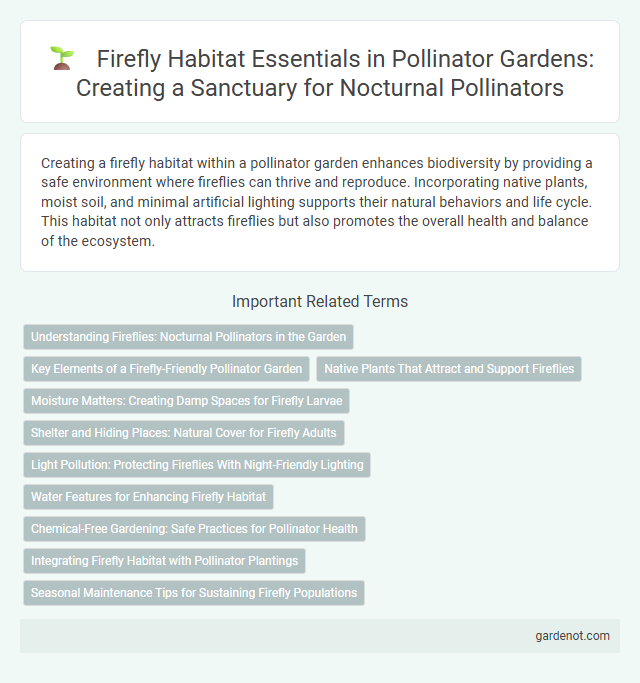Creating a firefly habitat within a pollinator garden enhances biodiversity by providing a safe environment where fireflies can thrive and reproduce. Incorporating native plants, moist soil, and minimal artificial lighting supports their natural behaviors and life cycle. This habitat not only attracts fireflies but also promotes the overall health and balance of the ecosystem.
Understanding Fireflies: Nocturnal Pollinators in the Garden
Fireflies, known for their bioluminescent glow, are vital nocturnal pollinators contributing to garden biodiversity. Their habitat requires moist environments with abundant vegetation and minimal pesticide use to support their life cycle from larvae to adult fireflies. Creating a pollinator garden with native plants and water sources enhances firefly populations, promoting natural pest control and nighttime pollination.
Key Elements of a Firefly-Friendly Pollinator Garden
A firefly-friendly pollinator garden features dense, moist vegetation and tall grasses that provide essential shelter and breeding grounds. Incorporating native flowering plants ensures ample food sources for fireflies during their active periods. Minimizing artificial light pollution preserves natural firefly behavior and enhances their visibility for pollination activities.
Native Plants That Attract and Support Fireflies
Native plants such as goldenrod, Joe-Pye weed, and ironweed create ideal habitats that support firefly populations by providing essential nectar sources and shelter. These native species thrive in moist, well-drained soils typical of firefly habitats, promoting nighttime mating displays and larval development. Incorporating native wildflowers and grasses ensures a sustainable ecosystem that fosters firefly attraction and breeding success.
Moisture Matters: Creating Damp Spaces for Firefly Larvae
Firefly larvae thrive in moist environments with damp soil or leaf litter, essential for their development and survival. Creating shaded, water-retentive areas with organic mulch and native plants helps maintain consistent moisture levels. These conditions support the larvae's ability to hunt small invertebrates, crucial for sustaining firefly populations in pollinator gardens.
Shelter and Hiding Places: Natural Cover for Firefly Adults
Firefly adults rely on dense vegetation, fallen leaves, and decaying wood as essential shelter and hiding places to thrive in a pollinator garden. These natural covers provide protection from predators and harsh weather, creating safe microhabitats for mating and resting. Incorporating diverse plant layers and maintaining undisturbed leaf litter enhances firefly habitat quality, promoting their population stability.
Light Pollution: Protecting Fireflies With Night-Friendly Lighting
Light pollution severely disrupts firefly mating signals, threatening their populations in pollinator gardens. Implementing night-friendly lighting such as low-intensity, warm-colored LED bulbs minimizes disruption and helps preserve firefly habitats. Maintaining dark sky conditions supports the natural behavior and reproduction rates of these vital nocturnal pollinators.
Water Features for Enhancing Firefly Habitat
Water features such as shallow ponds and damp soil areas create ideal moisture levels that support the survival and reproduction of fireflies. Incorporating natural water sources in pollinator gardens increases habitat complexity, encouraging fireflies to thrive by providing essential breeding grounds and hydration spots. Maintaining clean, chemical-free water ensures a healthy environment for firefly larvae and enhances the overall biodiversity of the garden.
Chemical-Free Gardening: Safe Practices for Pollinator Health
Creating a firefly habitat in a pollinator garden requires chemical-free gardening practices that ensure the health and safety of these bioluminescent insects. Avoiding pesticides and herbicides preserves the natural ecosystem, supporting fireflies' breeding and feeding behaviors. Planting native vegetation and maintaining moist leaf litter enhances organic matter, providing crucial shelter and nourishment for firefly larvae and adults.
Integrating Firefly Habitat with Pollinator Plantings
Integrating firefly habitat with pollinator plantings enhances biodiversity by creating a multifunctional garden space that supports both nocturnal and diurnal pollinators. Fireflies thrive in moist, undisturbed areas with ample leaf litter and native plants such as goldenrod and milkweed, which also attract bees, butterflies, and other pollinators. Establishing these habitats together boosts ecosystem health, improves pollination efficiency, and promotes natural pest control.
Seasonal Maintenance Tips for Sustaining Firefly Populations
Regularly mowing surrounding grasses in late fall prevents excessive thatch buildup, which can hinder firefly larvae development. Retain moist, undisturbed leaf litter and fallen wood throughout winter to provide essential overwintering sites. Minimize pesticide use and avoid nighttime light pollution to promote a healthy environment for firefly mating and reproduction.
Firefly habitat Infographic

 gardenot.com
gardenot.com